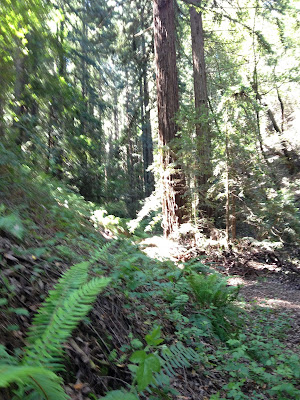Crabapples, Berries, Winter Bloomers and Winter Bird Flocks
 |
| Cedar Waxwing with its favorite winter food, berries. (Cheapshot/Wikimedia) |
by Sharol Nelson-Embry
As I was out walking the dog just before another big rainstorm hit our Island City the other day, I noticed large flocks of birds in the bare tree branches. As I paused and my bird dog lifted her head in interest, I thought they were probably ordinary, non-native starlings. After parsing out their calls, though, I was excited to find it was actually two separate flocks — one of robins and one of cedar waxwings!
The waxwings are one of my favorite birds and among the first I could readily identify in my college ornithology class. I was so excited about them, that I showed them to my husband when we were dating. He was later able to point them out on campus to another pair of students that were interested in them. He told them the birds name and let them know how special they were. That was his first time as a “bird whisperer.” He’s never forgotten it.
 |
| Notice the red wingtips and yellow tail feather tips on this Cedar Waxwing. (Dawn Huczek/Wikimedia) |
There are lesser-known group names for flocks of birds, and cedar waxwing flocks are called an “ear-full” or a “museum.” The name “ear-full” is appropriate as they call back and forth almost constantly — a noisy wheezing sound like a continuous, quiet calliope which may function to keep the flock together and communicate any nearby food source or danger. Their call is so unique, it almost always alerts me to their presence. A “museum” of waxwings is fitting, too, as I find them to be one of the most beautiful birds with careful details like the almost-airbrushed feathers, a masked face, and dots of bright color at the end of their wings and tails. These waxy dots are pigmented by the berries they eat. In the 19602 a scientist noted that in the Northeastern US, the colors at the ends of their tail feathers changed from yellow to orange when the birds began eating honeysuckle berries from people’s yards.They’re common throughout North America and travel nomadically spending the winter in the southern areas of the US and roaming to the far north and Canada to nest in the spring. I always look for them in winter when they’re busy stripping old berries off a variety of plants both in my neighborhood as well as parklands around our area.
 |
| A flock of robins feeding on winter fruit. (Adam Piotuch/Wikimedia) |
Robins are another group that are common and widespread throughout the US, but have surprising habits most people don’t know about. I take for granted that robins are in our area almost year round, but I hadn’t noticed before that they congregate in winter. With a little research, I found that robins are actually notorious nomads and gather in flocks, or “rounds” as they’re called, during winter. They don’t have a set migration, like many other songbirds, but round up and go searching for berries and winter fruit. There may even be birds joining them from the states to the north and east of ours with a lot of mixing during the winter. Their scientific name even indicates this, Turdus migratorius, meaning “wandering thrush.” Grouping up helps them, with more birds looking for winter food sources — those luscious, if overripe berries, crabapples, and other fruit left on trees and vines — as well as keeping an eye out for predators such as hungry, bird-eating Cooper’s hawks that maraud in my neighborhood.
 |
| Male Anna's Hummingbird with a dark throat patch. In the sun it flashes an irridescent red to catch the female's eye. (Steve Bernardi/Wikimedia) |
Lastly, have you noticed a “charm” of hummingbirds visiting your flowers and feeders? My camellia trees are a hotbed of hummingbird activity and their antics are completely charming! Our winter hummingbirds are almost all the Anna’s hummingbird species. They stick around throughout the winter while the other hummingbird species migrate south. Normally a very independent little bird, scientists are studying the flocking behavior they’ve begun to exhibit due to our feeders. They want to know if our feeders put them at risk for increased disease transmission and what other behavioral changes might be happening due to our influence. An article I read even showed the super-tiny little RFD devices they’re using to tag and track the hummingbirds in the study. Just a side note, if you do provide hummingbirds with a nectar feeder, be sure to follow all recommended cleaning precautions so you don’t end up making them sick with a fungal or bacterial infection. You might also want to plant a nectar garden for them and our beautiful butterflies.
For more information about these birds visit these links:
To read the study about hummingbirds see:


Comments
Post a Comment